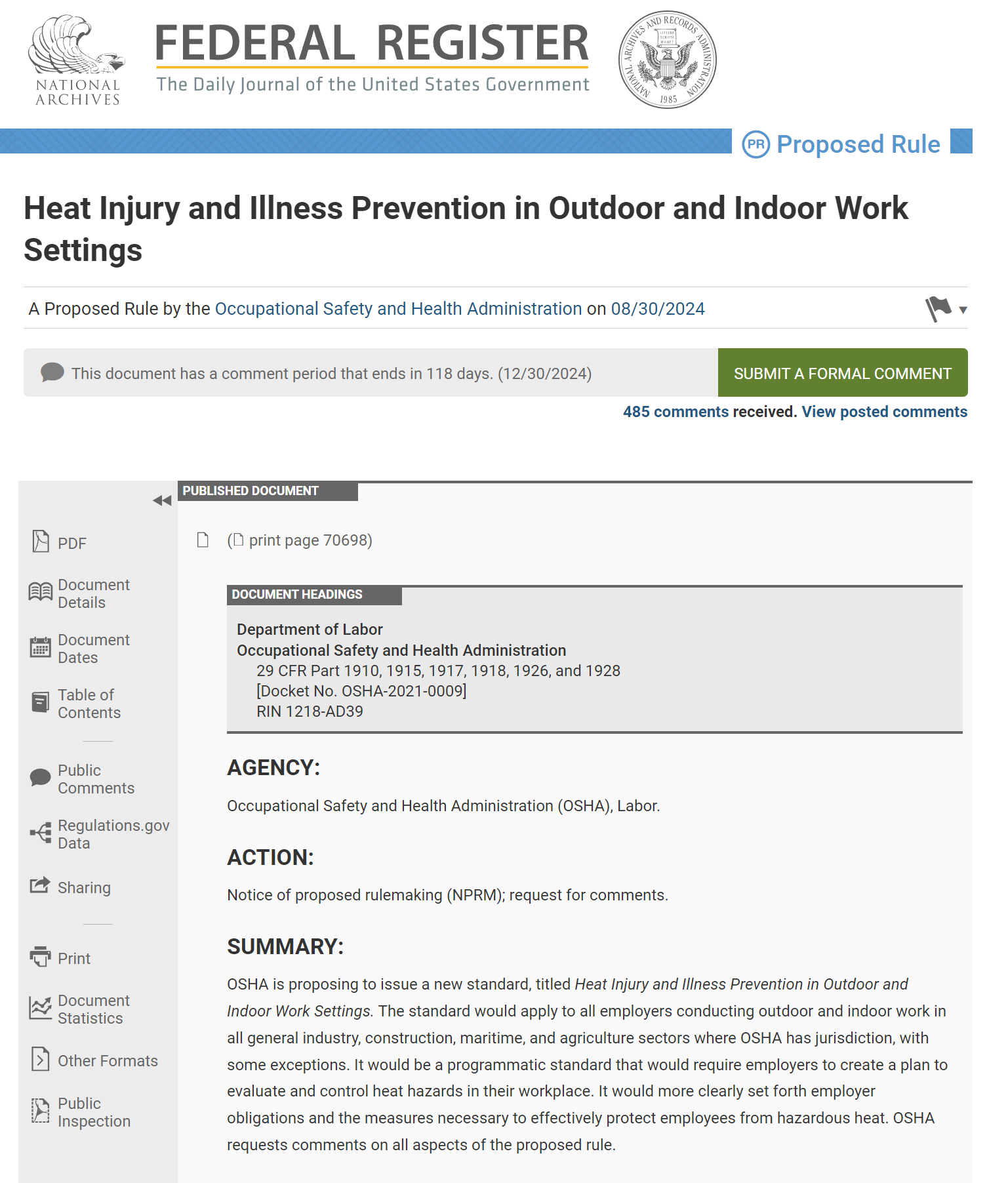What you need to know about OSHA’s new heat rule

The Non-Ferrous Founders' Society (NFFS), representing the interests of the non-ferrous foundry industry, is closely examining the OSHA Notice of Proposed Rulemaking (NPRM) entitled “Heat Injury and Illness Prevention in Outdoor and Indoor Work Settings.” This proposed rule, published in the Federal Register on August 20, 2024, introduces significant new regulations that will impact our member foundries and the broader non-ferrous metalcasting industry. This article provides a brief analysis of the proposed rule, focusing on its requirements for a Heat Injury and Illness Prevention Plan (HIIPP) that will be required by each covered employer.
Overview of the Proposed OSHA Rule
 The proposed rule applies to all employers where workers are exposed to hazardous heat, regardless of whether the environment is indoors or outdoors. For non-ferrous foundries, this is particularly relevant due to the high-heat operations involved in metal casting processes, such as furnace operations and molten metal handling.
The proposed rule applies to all employers where workers are exposed to hazardous heat, regardless of whether the environment is indoors or outdoors. For non-ferrous foundries, this is particularly relevant due to the high-heat operations involved in metal casting processes, such as furnace operations and molten metal handling.
Non-ferrous foundries must conduct thorough and regular assessments of heat hazards in their facilities. This includes evaluating areas where heat-generating processes occur, considering factors such as ambient temperature, humidity, radiant heat from furnaces, and the impact of PPE on heat stress. Continuous monitoring of these conditions is essential for maintaining a safe work environment.
The rule mandates the creation and implementation of a comprehensive Heat Injury and Illness Prevention Plan (HIIPP) that includes engineering controls, administrative controls, personal protective equipment (PPE), training, and emergency response measures. The rule also requires employers to monitor heat conditions continuously, provide training, and to implement necessary measures to prevent heat-related illnesses at certain temperature thresholds.
Required Content for a Heat Injury and Illness Prevention Plan (HIIPP)
- Engineering Controls: The HIIPP should detail the implementation of engineering controls, such as advanced ventilation systems, cooling equipment, and heat shields, to mitigate heat exposure in high-risk areas.
- Administrative Controls: Administrative measures, including the establishment of work/rest cycles, provision of air-conditioned rest areas, and scheduling of high-intensity tasks during cooler parts of the day, are necessary to reduce heat stress on workers.
- Personal Protective Equipment (PPE): The plan must ensure that PPE is designed to protect workers from heat while not contributing to additional heat stress. The selection of appropriate PPE that is both heat-resistant and comfortable is crucial.
- Hydration and Rest Breaks: The plan must guarantee that employees have access to cool drinking water and are encouraged to take regular hydration and rest breaks, particularly during peak heat periods.
- Acclimatization Programs: Acclimatization is vital for new employees and those returning to work after extended absences. The HIIPP must include procedures for gradually increasing these workers' exposure to heat over a period of days, allowing their bodies to adjust safely to the working environment.
- Training and Education: The HIIPP should include a robust training program for all employees and supervisors. Training must cover the recognition of heat-related illnesses, first-aid procedures, the importance of hydration, and the correct use of PPE. Supervisors must also be trained to monitor workers for signs of heat stress and to enforce the implementation of the HIIPP.
- Emergency Response: The HIIPP must outline clear and actionable emergency procedures for responding to heat-related illnesses. This includes steps to take immediately if an employee exhibits symptoms of heat stress, ensuring the availability of emergency response equipment like cooling blankets or ice packs, and coordinating with local medical services for rapid intervention in severe cases.
- Recordkeeping: Recordkeeping is a critical component of the HIIPP. Non-ferrous foundries must maintain detailed records of all heat-related incidents, environmental monitoring data, and training activities. Regular reviews of these records are necessary to update and improve the HIIPP continually.
- Implementation at No Cost to Employees: The rule mandates that all protective measures, including engineering controls, PPE, and provisions for water and rest breaks, must be provided by the employer at no cost to the employees. This ensures that all workers have access to necessary protections without financial burden.
- Compliance Dates: The HIIPP should include a phased implementation plan, ensuring that all aspects of the rule are fully implemented by the specified compliance dates. This phased approach allows foundries to integrate these requirements into their operations systematically.
While the proposed rule introduces new costs and operational challenges, our industry is resilient and capable of adapting to these changes without jeopardizing long-term viability. The flexibility built into the rule allow our industry to implement cost-effective and technologically feasible solutions tailored to our specific needs.
NFFS will continue to work closely with our Government Affairs Committee, our Board of Directors, and other stakeholders to ensure that our members have the resources and guidance necessary to comply with this rule and to maintain the highest standards of worker safety in the non-ferrous foundry industry.
